Jump to Video
IFLS, NWLS, and WVLS websites use Matomo Analytics to track website use information. A basic website stats summary is available on the Connect Matomo Dashboard on each website WordPress dashboard. If you are a website manager and want to dig deeper into your website’s analytics, email websitehelp@librarieswin.org to request a login, and read on.
[If you are from a WRLS website, chances are you have Monster Insights installed. The same general principles and terminology apply, but the dashboard will look different.]
Topics covered here:
Analytics Metrics Defined
Here are some of the key metrics you will encounter when reviewing your website analytics. They are organized here by where they are located in Matomo, but they could be grouped slightly differently in Google Analytics, Monster Insights, or other analytics services.
Visitors > Overview
| Metric | Definition | Why It Matters for Libraries |
|---|---|---|
| Visits (Sessions) | A visit is a group of interactions by one visitor within a set time period (typically 30 minutes). | Shows overall traffic and activity on your site. |
| Unique Visitors |
The number of individual people who visited your site during the selected date range. Repeat visits from the same person count as 1. | Helps you understand how many different people use your site. |
| Pageviews | The total number of pages viewed (including repeated views by the same user). | Indicates how much content users are consuming. |
| Bounce Rate | The percentage of visitors who leave the site after viewing only one page. | A high bounce rate may suggest users aren’t finding what they expected or needed. |
| Average Visit Duration |
The average total time users spend on your site per visit. | Longer visits can suggest greater engagement or difficulty navigating. |
| Average Time on Page |
How long users spend on a specific page, on average. | Pages with very short times may be confusing, unhelpful, or hard to read. |
| Time | Time of day or day of the week website is experiencing traffic. | May help determine when updates to website should be posted so most visitors see the most up-to-date information. |
| Location | IP addresses of devices accessing website. Note that as of June 2025, IFLS, NWLS, WVLS websites have been moved behind a firewall to limit access from IP addresses outside of North America. | We expect most of our traffic to be from Wisconsin/bordering states. Can help determine if traffic is from legitimate sources or automated bots. |
Visitors / Devices
| Metric | Definition | Why It Matters for Libraries |
|---|---|---|
| Devices / Browsers | Shows what devices (mobile/desktop/tablet) and browsers are being used. | Essential for checking mobile-friendliness and compatibility. |
Behavior > Pages / Page Titles, Referrers
| Metric | Definition | Why It Matters for Libraries |
|---|---|---|
| Top Pages / Page Titles | Shows which pages are viewed most often. | Helps prioritize updates or accessibility improvements to high-traffic pages. |
| Entry Pages | The first page someone sees when they come to your site. | Important for identifying where users “land” — are they starting at your homepage or elsewhere? |
| Exit Pages | The last page a visitor sees before leaving the site. | Helps identify where users drop off — and whether key pages are causing confusion. |
Behavior > Downloads / Outlinks
| Metric | Definition | Why It Matters for Libraries |
|---|---|---|
| Downloads | Tracks clicks on downloadable files (PDFs, docs, etc.). | Useful for monitoring handouts, forms, and policy documents. |
| Outlinks | Clicks on links that take users away from your website (e.g. to Libby, OverDrive, catalog). | Measures how often users follow links to external resources. |
Acquisition > Overview / All Channels
| Metric | Definition | Why It Matters for Libraries |
|---|---|---|
| Referrers | Where your visitors came from (search engines, other websites, direct link, etc.) | Tells you which promotion methods are working — like newsletter links or social media. |
Visitors: Overview
Visitors > Overview
| Metric | Definition | Why It Matters for Libraries |
|---|---|---|
| Visits (Sessions) | A visit is a group of interactions by one visitor within a set time period (typically 30 minutes). | Shows overall traffic and activity on your site. |
| Unique Visitors |
The number of individual people who visited your site during the selected date range. Repeat visits from the same person count as 1. | Helps you understand how many different people use your site. |
| Pageviews | The total number of pages viewed (including repeated views by the same user). | Indicates how much content users are consuming. |
| Bounce Rate | The percentage of visitors who leave the site after viewing only one page. | A high bounce rate may suggest users aren’t finding what they expected or needed. |
| Average Visit Duration |
The average total time users spend on your site per visit. | Longer visits can suggest greater engagement or difficulty navigating. |
| Average Time on Page |
How long users spend on a specific page, on average. | Pages with very short times may be confusing, unhelpful, or hard to read. |
| Time | Time of day or day of the week website is experiencing traffic. | May help determine when updates to website should be posted so most visitors see the most up-to-date information. |
| Location | IP addresses of devices accessing website. Note that as of June 2025, IFLS, NWLS, WVLS websites have been moved behind a firewall to limit access from IP addresses outside of North America. | We expect most of our traffic to be from Wisconsin/bordering states. Can help determine if traffic is from legitimate sources or automated bots. |
Visitors / Devices
Visitors / Devices
| Metric | Definition | Why It Matters for Libraries |
|---|---|---|
| Devices / Browsers | Shows what devices (mobile/desktop/tablet) and browsers are being used. | Essential for checking mobile-friendliness and compatibility. |
Behavior: Pages, Page Titles, Referrers
Behavior > Pages / Page Titles, Referrers
| Metric | Definition | Why It Matters for Libraries |
|---|---|---|
| Top Pages / Page Titles | Shows which pages are viewed most often. | Helps prioritize updates or accessibility improvements to high-traffic pages. |
| Entry Pages | The first page someone sees when they come to your site. | Important for identifying where users “land” — are they starting at your homepage or elsewhere? |
| Exit Pages | The last page a visitor sees before leaving the site. | Helps identify where users drop off — and whether key pages are causing confusion. |
Behavior: Downloads / Outlinks
Behavior > Downloads / Outlinks
| Metric | Definition | Why It Matters for Libraries |
|---|---|---|
| Downloads | Tracks clicks on downloadable files (PDFs, docs, etc.). | Useful for monitoring handouts, forms, and policy documents. |
| Outlinks | Clicks on links that take users away from your website (e.g. to Libby, OverDrive, catalog). | Measures how often users follow links to external resources. |
Acquisition: Overview / All Channels
Acquisition > Overview / All Channels
| Metric | Definition | Why It Matters for Libraries |
|---|---|---|
| Referrers | Where your visitors came from (search engines, other websites, direct link, etc.) | Tells you which promotion methods are working — like newsletter links or social media. |
Matomo Interface Tour
[If your library is a LEANWI website in IFLS, NWLS, or WVLS, you can request a user login to view your website analytics. Email websitehelp@librarieswin.org to request yours.]
When you log into https://analytics.iflsweb.org/ you will see your overview and a link to your library’s website analytics.

When you click on the name of your site, you will land on your analytics dashboard.
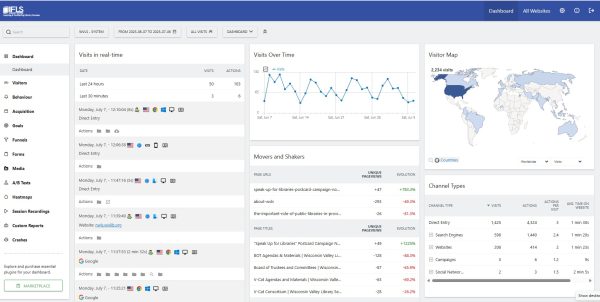
We’re going to bypass the overview for a minute and look at specific metrics under Visitors, Behavior, and Acquisitions.
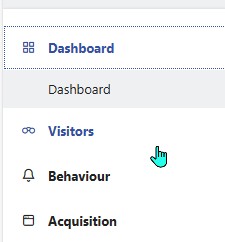
Matomo Interface Tour - Visitors
Visitors
Visits Log shows a list of individual visitors and their actions for a given time period. This can be useful for a snapshot of how an individual user is using your site.

Devices gives us an idea of how people are accessing websites – from device type, operating systems, etc. Note you can change the list to a different visualization type (pie chart, bar chart, overlay with visitor behaviors, etc.), and you can export as reports.
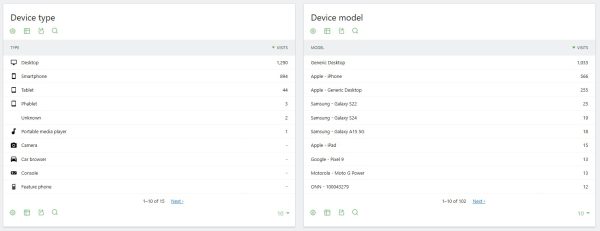
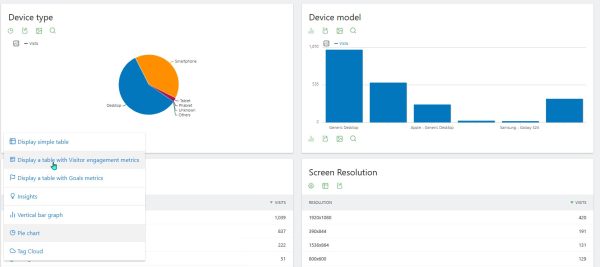
Real time for hour of day or day per week shows us when visitors are coming to sites.

Matomo Interface Tour - Behavior
Pages/Page Titles
The main difference between “Pages” and “Page Titles” is Pages lists the visits by URL and Page Title uses the name given to the page or post. Totals may differ slightly based on the way Page Titles are mapped to URLs.
Note options for viewing the reports.
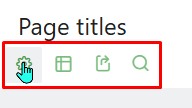
You can also exclude low hit pages and just review the most popular pages.
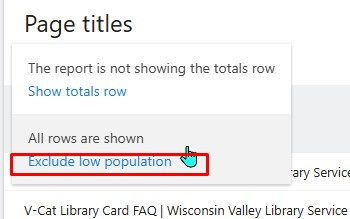
Entry/Exit Pages
Knowing how visitors get to a particular page and where they go after is also enlightening. Use the Entry Pages and Exit Pages to review visitor behaviors. (note /index indicates the home page)
When you hover over the page URL, the option to View Transitions pops up.

This can help visualize how visitors are finding a page, and where they go after visiting that page.
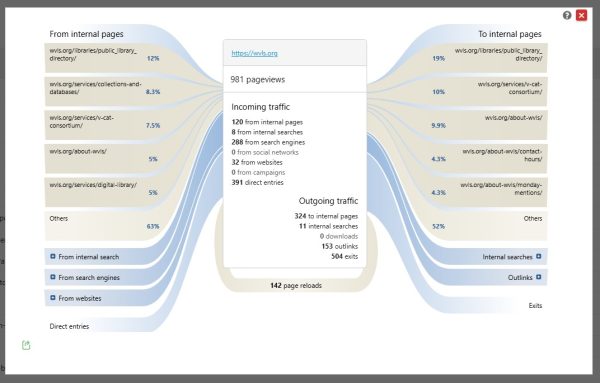
Clicking on the small [+] signs on the blue sections will expand the categories (internal search, search engine, websites > internal searches, outlinks, exits).
Site Search
If people are searching for something on your site, this section will show the search terms and the number of pages they got back as a result. It is possible to view the log file for the visitor to see other associated searches or actions associated with that search/visit. This page also displays the pages people navigated to after searching your website.
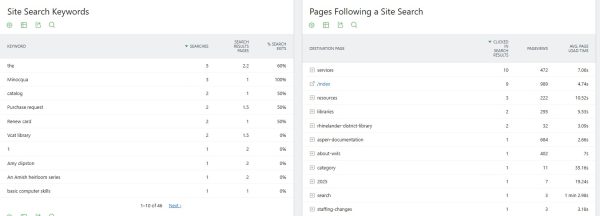
Outlinks
Shows where visitors go when they click on a link and leave your website.
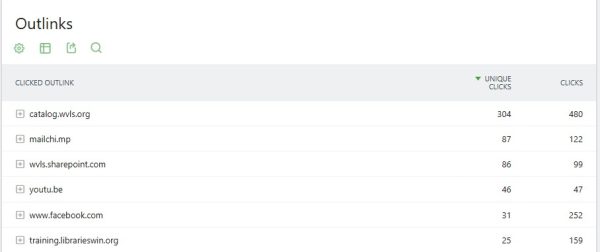
Downloads
If your website has documents or links to documents available for users to download, this section will show you which downloads media items that are linked on your site are the most popular.
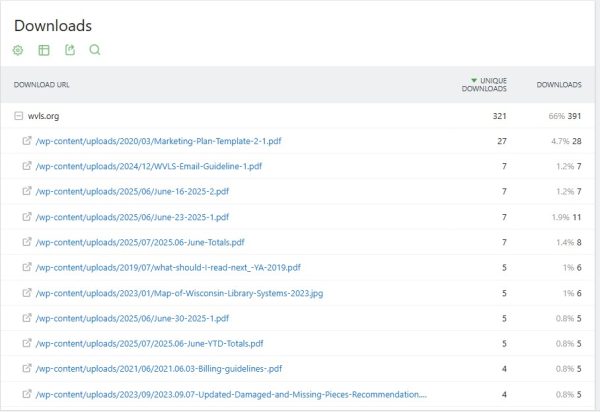
Matomo Interface Tour - Aquisition
Acquisition is how visitors arrived at your website. Options are:
- Direct entry (they typed your URL into a browser or used a bookmark to navigate directly to your site)
- Search engines
- Other websites (they came to your site from a link on another website)
- Campaigns (link from a newsletter or other external source that labels itself a marketing campaign)
- Social networks
Search Engines and Keywords
This will list the search engines used when a visitor used a search link to arrive at your website.
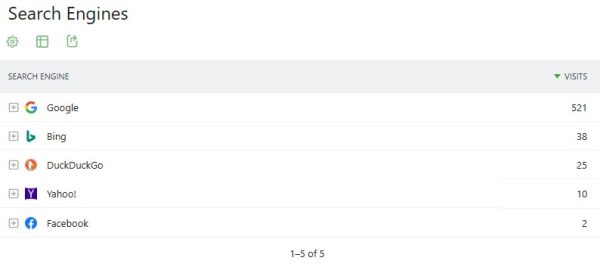
Keywords are often not defined due to user privacy or other search engine settings.
Other websites
This gives a list of other websites that link to pages on your website.
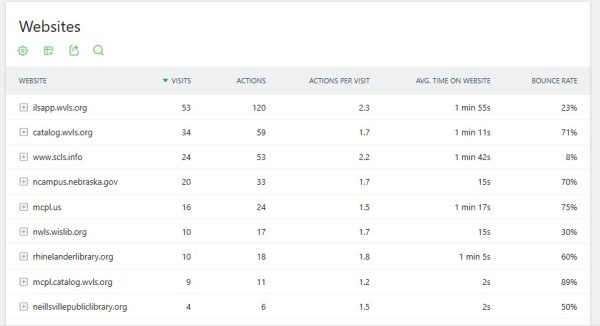
Campaigns
If you have a newsletter or other tool that promotes your website, clicked links will often be listed here.
Social networks
You can keep track of which social network sends users to your website.

